Messier 106 (also known as NGC 4258) is an intermediate spiral galaxy in the constellation Canes Venatici. M106 is at a distance of about 22 to 25 million light-years away from Earth.
M106 contains an active nucleus classified as a Type 2 Seyfert, and the presence of a central supermassive black hole has been demonstrated from radio-wavelength observations of the rotation of a disk of molecular gas orbiting within the inner light-year around the black hole. NGC 4217 is a possible companion galaxy of Messier 106. A Type II supernova was observed in M106 in May 2014.
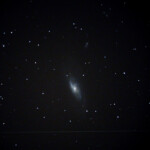
Messier 106 (also known as NGC 4258)
A very early attempt to capture M106 with the CPC 925 reflector telescope and the Nikon D800 DSLR in Åva, March 2015. No guiding present.
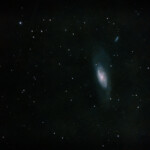
Messier 106 (also known as NGC 4258)
A year later still using the CPC 925 reflector telescope and the Nikon D800 camera in Stuvsta, April 2016. Exposure was 14*30s, this time with guiding.
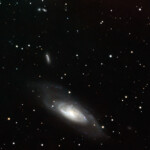
Messier 106 (also known as NGC 4258)
Messier 106 (also known as NGC 4258) is an intermediate spiral galaxy in the constellation Canes Venatici. M106 is at a distance of about 22 to 25 million light-years away from Earth.
M106 contains an active nucleus classified as a Type 2 Seyfert, and the presence of a central supermassive black hole has been demonstrated from radio-wavelength observations of the rotation of a disk of molecular gas orbiting within the inner light-year around the black hole. NGC 4217 is a possible companion galaxy of Messier 106.
Photographed with MN 190 reflector telescope and Atik 360EX monochrome CCD camera in Åva, March 2020. Exposure was 18 minutes with R,G,B, and Lum.

Messier 106 (also known as NGC 4258)
Messier 106 (also known as NGC 4258) is an intermediate spiral galaxy in the constellation Canes Venatici. M106 is at a distance of about 22 to 25 million light-years away from Earth. M106 contains an active nucleus classified as a Type 2 Seyfert, and the presence of a central supermassive black hole has been demonstrated from radio-wavelength observations of the rotation of a disk of molecular gas orbiting within the inner light-year around the black hole. NGC 4217 is a possible companion galaxy of Messier 106. A Type II supernova was observed in M106 in May 2014.
Photographed with APO107mm refractor telescope and ASI 2600MC color camera in Stuvsta, February 2022. Exposure was 16*3min with IDAS LPS P3 light pollution filter.

Messier 106 (also known as NGC 4258)
Messier 106 (also known as NGC 4258) is an intermediate spiral galaxy in the constellation Canes Venatici. M106 is at a distance of about 22 to 25 million light-years away from Earth. M106 contains an active nucleus classified as a Type 2 Seyfert, and the presence of a central supermassive black hole has been demonstrated from radio-wavelength observations of the rotation of a disk of molecular gas orbiting within the inner light-year around the black hole. NGC 4217 is a possible companion galaxy of Messier 106. A Type II supernova was observed in M106 in May 2014.
Photographed with APO107mm refractor telescope and ASI 2600MC color camera in Stuvsta, February 2022. Exposure was 16*3min with IDAS LPS P3 light pollution filter.
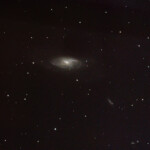
Messier 106 (also known as NGC 4258)
Messier 106 (also known as NGC 4258) is an intermediate spiral galaxy in the constellation Canes Venatici. M106 is at a distance of about 22 to 25 million light-years away from Earth. M106 contains an active nucleus classified as a Type 2 Seyfert, and the presence of a central supermassive black hole has been demonstrated from radio-wavelength observations of the rotation of a disk of molecular gas orbiting within the inner light-year around the black hole. NGC 4217 is a possible companion galaxy of Messier 106. A Type II supernova was observed in M106 in May 2014.
Photographed with RC8″ reflector telescope and ASI 2600MC color camera in Stuvsta, March 2023. Exposure was 30*2min with IDAS HEUIB filter. OAG with ASI432 guide camera.
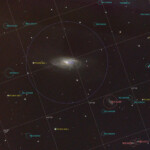
Messier 106 (also known as NGC 4258)
Messier 106 (also known as NGC 4258) is an intermediate spiral galaxy in the constellation Canes Venatici. M106 is at a distance of about 22 to 25 million light-years away from Earth. M106 contains an active nucleus classified as a Type 2 Seyfert, and the presence of a central supermassive black hole has been demonstrated from radio-wavelength observations of the rotation of a disk of molecular gas orbiting within the inner light-year around the black hole. NGC 4217 is a possible companion galaxy of Messier 106. A Type II supernova was observed in M106 in May 2014.
Photographed with RC8″ reflector telescope and ASI 2600MC color camera in Stuvsta, March 2023. Exposure was 30*2min with IDAS HEUIB filter. OAG with ASI432 guide camera.